There is no one-size-fits-all answer to the question “Why is my dog limping?” Integrative veterinarian Dr. Julie Buzby defines the types of limping in dogs, lists some common causes of limping in dogs, and explains what you can do at home to help your dog feel better until you can see your vet.
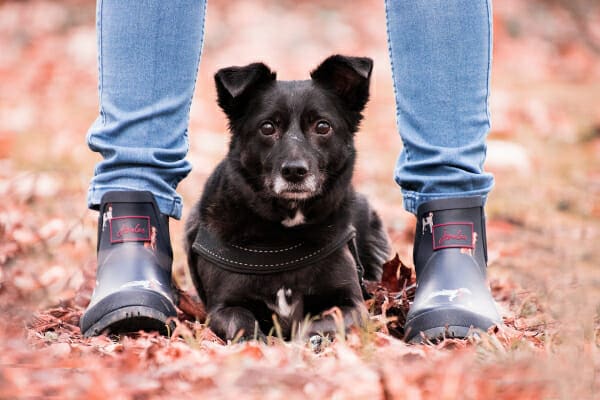
Why is my dog limping? Should I go to the vet? Or does this warrant an emergency vet visit?
Dogs can’t tell us why they are limping, toe touching, or favoring a leg. Getting to the root of the problem is up to diligent pet parents and veterinarians.
To help you, let’s look at types of limping, possible causes, and what you can do.
Gradual vs. sudden limping
First, it’s helpful to know that there are two types of limping: gradual and sudden onset. Differentiating between these two categories can help narrow down the cause of your dog’s limping and determine next steps.
Sudden onset lameness
In some cases, a seemingly healthy dog trots outside on four good legs and returns hobbling on three legs. Perplexed owners may be left wondering, “Why is my dog suddenly limping?”
Sudden onset lameness occurs from some sort of acute injury or trauma. These dogs do not generally have any evidence of an underlying problem and experience an injury that leads to sudden limping.
Possible reasons for sudden onset lameness can vary from something lodged in between the paw pads to a broken bone.
5 reasons for sudden onset lameness
1. Something stuck in the dog’s paw
One of the first things I check on a dog with sudden onset lameness is the sensitive paw pads. If you’ve ever stepped outside barefoot and regretted it the second your foot lands on a sharp thorn or object, you know why this might cause your dog to limp!
Dogs’ paw pads are very much like the bottoms of our feet, and if something sharp is lodged in there, it hurts! If your dog has sudden onset lameness, check the bottoms of his or her paws (gently) to see if something is stuck in there.
If you do find something stuck in your dog’s paw, you may be able to gently remove it, or you may need veterinary assistance. Even if you’re able to remove the stuck item at home, it’s a good idea to follow up with your vet to make sure the area doesn’t become infected.
2. Insect bite or sting
Ants, spiders, wasps…any stinging or biting bug that causes painful reactions in humans can do the same in dogs. If your pup prances through a fire ant pile, he or she may not be eager to walk on that paw for a bit!
Sometimes bites or stings can be hard to detect because they’re covered by a dog’s fur.
Occasionally, dogs can have allergic reactions to insect bites/stings and we can see other side effects such as facial swelling, hives, vomiting, and lethargy. If you notice these symptoms, call your vet right away!
3. Strain or tear
Dogs can injure their ligaments, tendons, and muscles just like people can. These types of injuries can vary from a minor “tweak” that resolves with a bit of rest, to something like a torn ACL in dogs that may require surgical repair. This type of injury often makes dogs reluctant to put weight on the affected leg. Your vet can help you differentiate a minor injury from something more serious.
4. Trauma/broken bone
A serious fall or injury may result in a broken bone. Typically, dogs with broken bones are “non-weight-bearing,” meaning they are holding the broken paw up and not standing on it at all. An X-ray at your vet’s office will determine whether your limping dog has a fracture.
5. Broken toenail
If you’ve ever inadvertently cut a dog’s nail too short during a dog nail trim, you know how painful it can be. Sometimes dogs’ nails can get caught on something and split or break near the base, where the sensitive quick is. If your dog ripped a nail off, he or she can experience sudden onset limping.
No matter the cause, if your dog is suddenly limping, it is important to get him or her to the veterinarian for diagnostics and treatment, including pain relief. (More on how urgent the vet visit is in a bit.)
Next, let’s address the other side of the coin—gradual onset lameness.
Gradual onset lameness in dogs
Instead of coming up acutely lame, some dogs may have a gradual onset limp that vets would classify as “chronic.”
In gradual onset lameness, you may notice your dog limping on and off, and some days he or she may seem more painful than others. This may coincide with changes in the weather, increased activity, or even the life stage of your dog.
Even if your dog is only limping intermittently, it indicates that he or she is experiencing pain, and should be seen by a veterinarian. Just like sudden onset lameness, gradual onset limping has several causes.
7 reasons why your dog may have gradual onset limping
Potential causes for chronic lameness can include:
- Osteoarthritis in dogs (i.e. degenerative joint disease)
- Tumors in the bone or soft tissue
- Cruciate ligament disease—an acute CCL tear causes sudden limping, but gradual limping can be seen in dogs that have a partial CCL tear or a dog may be chronically lame from an untreated or undiagnosed prior CCL tear
- Back injuries or spinal/neurologic abnormalities such as spondylosis in dogs
- Tick-borne disease in dogs—diseases transmitted through tick bites, such as Lyme disease, can cause severe lameness and other health issues
- Soft tissue inflammation (i.e. “weekend warrior syndrome”)—generalized muscle soreness following strenuous activity or play
- Hip dysplasia in dogs

If your dog seems to have gradual onset lameness, it can be very helpful to bring videos of your dog limping to your appointment. Sort of like bringing your car to the mechanic where it won’t make that noise it’s been making for weeks, the adrenaline of a vet visit may mask your dog’s limping and make diagnosis more challenging.
A brief journal of activities and circumstances that tend to exacerbate your dog’s pain could also help your vet determine the underlying cause.
What should I do if my dog is limping?
Since causes of limping in dogs are so widely variable—from a thorn in the paw to a broken bone—it’s always best to seek veterinary care.
As a rule of thumb, head to the ER if your dog is limping and…
- Has a traumatic injury such as a big fall or has been hit by a car
- Might have a broken bone
- Has a bleeding wound
- Won’t put any weight on the leg or the leg is dangling
- Is crying out in pain
- Is paralyzed or dragging the back leg(s)

Call your regular vet if your dog is limping and…
- Will allow you to touch and manipulate the leg
- Is putting some weight on the leg and otherwise seems comfortable
- Has gradual/chronic limping that is not suddenly worse
When in doubt, always run your dog’s situation by the veterinary team. That way they can advise you on the best course of action.
If your vet agrees that a “non-emergency” appointment is appropriate, there are some ways you can help your dog at home in the meantime.
How can I help my limping dog right now?
While you are waiting to take your dog to your vet, you can do a few things to make him or her more comfortable at home.
1. Examine your dog.
Being careful not to exacerbate an injury, you can give your dog a gentle once over to try to localize the pain and see if there’s anything (such as a thorn in the paw) that can be addressed right away. Be sure to pay attention to your dog’s cues and stop if anything seems to be hurting him or her.
If your dog is limping on a front leg…
Trauma to the leg or foot tends to be a common culprit when your dog is acutely limping on his front leg (i.e. forelimb). Sometimes you will be able to see some obvious external signs that point to trauma.
To check your dog’s front leg:
- Have someone help you by holding your dog in a stable, supported position.
- Starting from the shoulder and working your way down to the toes, you can examine your dog’s leg for signs of injury, including:
- Heat or swelling
- Puncture wounds, lacerations, or bleeding
- Obvious fractures
- Thorns
- Glass or foreign bodies in the toe pads or between the toes
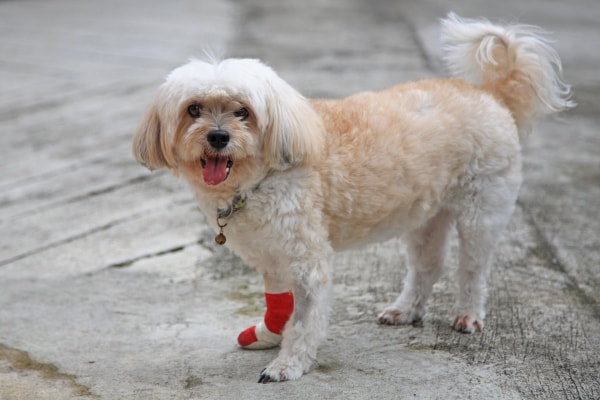
Less commonly, chronic forelimb lameness can be caused by certain bone diseases, such as osteoarthritis, elbow dysplasia, or hypertrophic osteodystrophy.
If your dog is limping on a back leg…
On the other hand, orthopedic problems are more likely to be the cause of acute rear leg (i.e. hindlimb) lameness. However, trauma is still a possibility.
To check your dog’s back leg:
- Have a helper support your dog while standing or lying down.
- Gently run your hands down the hind leg, starting from the hip and ending at the toes.
- Try to note any major changes or signs of discomfort. It can be very helpful to examine the “good” leg first. That way you will be able to note any subtle changes in the anatomy of the affected leg.
- After examining your dog, assess how he or she is walking. Does your dog only have a mild limp? Is he or she “toe touching” (i.e. reaching the leg to the floor but pulling it back up when the toenail/top of the foot touches)? Or is your dog holding his or her leg up completely without using it? This information can be used to help isolate the location and type of back leg injury.
- Common acute back leg injuries that lead to limping include, but are not limited to:
- Fractures (i.e. broken bones)
- Hip dislocation
- Torn ACL in dogs (the dog version of the human ACL injury)
- Patellar luxation (i.e. a kneecap that pops out of place)
- Broken toenails
- Soft tissue trauma such as punctures, bites, cuts, or foreign bodies
- Neurologic abnormalities (i.e. spinal stroke in dogs or intervertebral disk disease [IVDD in dogs])
2. Encourage your dog to rest.
Depending on what your dog’s injury is, excessive activity could exacerbate it. Until your dog can be assessed by your vet, it’s best to restrict activity.
If your dog is anxious, antsy, or overactive, you can use a crate or a small room (such as a bedroom or bathroom) to keep him or her more enclosed.
3. Leash walk your dog outside only long enough to use the bathroom.
Bathroom breaks are a must, but they should be on leash during this time. If your dog sees a squirrel and takes off, it could make his or her injury worse. It’s best to have physical control over your pup so that you can safely return inside once you dog’s finished their business.
4. Consider using a rolled towel as a sling to help support your dog’s body weight.
For dogs with hindlimb or back injuries, supporting their weight may be a challenge, particularly for large breed dogs. You can help the dog rise and walk by rolling up a towel or small blanket and using it as a sling under the belly. This takes some of the pressure off of the injured area and can help him or her get from place to place with less pain.
5. Keep a journal or video of your dog’s limping to share with your veterinarian.
Sometimes dogs get REALLY excited when they get to the hospital. As a result, the limping they have been doing at home for three days is suddenly nonexistent as they bounce around the exam room. Capturing your dog’s limp on video or making some notes about your observations, will help your vet find the source of lameness.
What can I expect at my limping dog’s vet appointment?
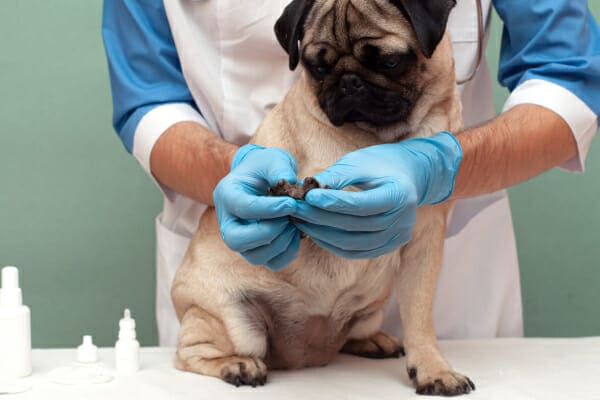
During the visit, your veterinarian will have two main goals:
- Find the source of the lameness
- Manage the pain while preventing further injury
To help accomplish the first goal, your veterinarian will ask you questions about the circumstances surrounding your dog’s limping. This is where your journal and videos can come in handy.
Your vet will then perform an orthopedic and physical examination to attempt to localize where the pain is coming from. During the orthopedic exam, the vet will watch your dog walk. Also, he or she will palpate and manipulate the bones and joints in the leg.
This will most likely be followed by X-rays of the affected leg. In some cases, your vet may recommend taking the X-rays under sedation or anesthesia. This helps make the process more comfortable for your dog. It also ensures that the vet is able to get good quality diagnostic images.
Your vet may also recommend some advanced lab testing such as a complete blood count, serum biochemistry, or urinalysis. These tests can point to signs of infections or other problems that can lead to lameness. Additionally, this bloodwork helps to ensure that your dog is healthy enough to take some of the most common pain control medications or to undergo anesthesia and surgery if needed.
Advanced diagnostics
In rare cases of limping, your veterinarian may recommend higher-level diagnostics to isolate some less-often seen causes of lameness. These tests can include:
- Joint taps (“arthrocentesis”)—removing a small amount of fluid from the joint and sending it to a lab for analysis
- Serologic (blood) testing for tick-borne diseases
- Orthopedic ultrasound
- CT—a great way to evaluate bones and joints
- MRI—shows signs of soft tissue and spinal disease well
The information your vet obtains from talking with you, the orthopedic and physical exams, and any other tests is critical to the diagnosis and treatment of many lameness-causing diseases. Dogs can’t “talk” to their veterinarians. So the vet must rely on the evidence he or she gathers to best treat the source of the pain.
Treating a limping dog
For some minor maladies, a quick fix will do the trick. Removing a foreign object in the paw or addressing a broken toenail are simple resolutions. More extensive causes of limping in dogs can mean more involved treatment plans. Your vet will work with you to come up with the best treatment plan for your dear dog.

Once your vet determines the cause of the limp, he or she will discuss the steps in the treatment plan. Sometimes it involves surgery such as TPLO surgery for dogs or fracture repair. Other times it is a matter of medical management.
Whether you are resting your limping dog after a mild, acute injury, or rehabilitating him or her after a major or chronic one, there are lots of ways to make your dog more comfortable and maximize the healing process.
Keep in mind, if your dog is limping, your dog IS in pain. Animals can have extremely high pain tolerances and the signs your dog is in pain can be subtle. Dogs will often be limping as a sign of pain but not necessarily crying out in pain. Just because your dog is still eating, drinking, walking, and playing does not mean he or she isn’t hurting!
Non-steroidal anti-inflammatory drugs (NSAIDs)
Your vet may prescribe a nonsteroidal anti-inflammatory drug (NSAID). These medications are highly effective at reducing pain and inflammation, which is why they are often the first choice for dogs who are limping.
It is very important that you give medications as prescribed. Do not give your dog medications that are not prescribed to him or her or ones that are left over from other pets. And absolutely do not use over-the-counter human medications without veterinary guidance. You cannot give your dog Advil, naproxen, or other similar medications, as these can be toxic to dogs.
Other pain medications
NSAIDs are not the best choice for every dog, for a variety of reasons. Your vet may choose other pain medications for your dog based on bloodwork, type of injury, concurrent medications, or other factors.
Some veterinarians will also recommend combining other medications such as tramadol for dogs, amantadine for dogs, or gabapentin for dogs with an NSAID to provide extra pain relief.
Again, do not give your dog any medications that were not specifically prescribed to him or her by the veterinarian for this particular problem.
Cold therapy
Using towel-wrapped ice packs on the affected area of the leg can be very beneficial in reducing pain, swelling, and inflammation. Three 15-minute sessions are typically recommended per day. If your dog does not tolerate cold therapy well, please stop and consult your veterinarian.
Weight management
In general, most dogs with an orthopedic injury could benefit from being a healthy weight. And in some cases, having a healthy body condition score can even help prevent injuries from occurring. To learn more about how to keep your dog trim and healthy, check out these three articles:
- Your Dog’s Body Condition Score (BCS): Find Your Dog’s Number
- How to Help a Dog Lose Weight
- Is My Dog Overweight?

Your vet can help you come up with a healthy and appropriate weight loss plan if he or she believes it will improve your dog’s orthopedic and/or overall health.
Joint support diets, supplements, and medications
You can support your dog’s orthopedic health by feeding a diet rich in eicosapentaenoic acids (EPA), one of the three types of omega-3 fatty acids for dogs or considering a fish oil supplement. Additionally, there are a variety of other excellent joint supplements for dogs that can help decrease joint inflammation and improve joint health.
One of my favorites is Dr. Buzby’s Encore Mobility™ hip and joint supplement. With a unique combination of green lipped mussel for dogs and deer antler velvet for dogs, Encore Mobility has the ability to work wonders for limping dogs. Take a look at the infographic below to learn more.
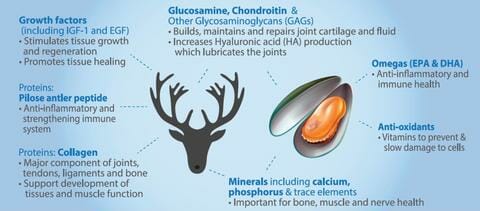
Encore Mobility is safe and effective, and the unique ingredients have made a huge difference in the lives of thousands of dogs over the years. But don’t just take my word for it—check out our Encore Mobility customer reviews.
Save 10% on Encore Mobility™ Joint Supplement for Dogs
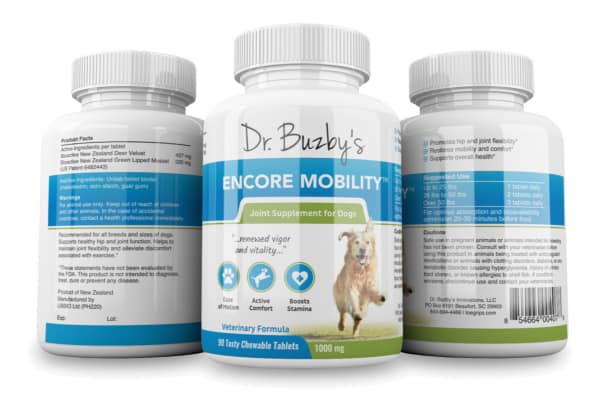
Give your dog more good days.
Use promo code HAPPY to save 10% on Encore Mobility.
Another great option is Adequan for dogs. This injectable medication has the ability to not only support the joints and reduce inflammation but also slow down the progression of osteoarthritis. It can be very useful for dogs with chronic (gradual onset) lameness caused by arthritis or for dogs with joint problems like hip dysplasia, patellar luxation, or ACL tears that can lead to arthritis.
Appropriate exercise restriction
A slow and steady recovery plan and gradual increase in activity are critical to appropriate healing of orthopedic injuries. Otherwise, your dog may take two steps forward and three steps back! Short-term crate rest is often best. If needed, you can ask your vet about mild sedation to help your pup stay relaxed and calm during the “bed rest” phase.
It’s a good idea to familiarize your dog with a crate before an injury may occur. If you want to learn more about crate training, check out this crate training guide from UC Davis School of Veterinary Medicine.
Special toys or treats can help keep your dog occupied during longer periods of crate rest.
Rehabilitation plan
You can also ask your vet about at-home rehab exercises to help with recovery. If there is a rehab specialty clinic near you, the team there can also help design a plan for your pup. Some rehabilitation clinics have specialized equipment, such as an underwater treadmill, that can aid in your dog’s recovery.
Laser therapy for dogs, visits to the dog chiropractor, or acupuncture can also be great options for rehab. Some general practice clinics offer those services. If not, the veterinary team may be able to refer you to another clinic that does.
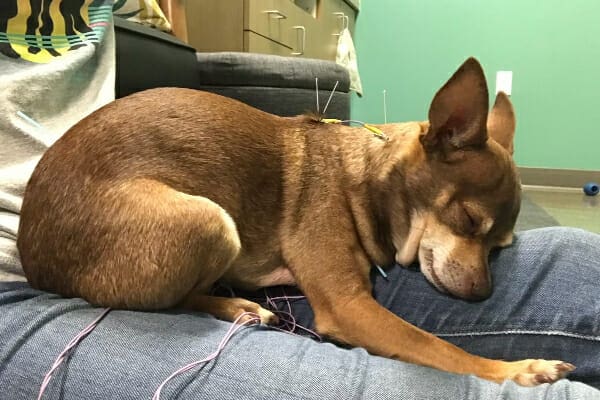
Environmental modifications
You can also take steps to make your home safer and more comfortable for your pup during the recovery period and beyond.
Try to limit how many stairs your dog needs to do in a day. At least initially, keep him or her from running, jumping, and roughhousing as much as possible. Using ramps to get in and out of the car or up and down from furniture also can be helpful.
If your dog has issues getting traction, especially on slippery floors, this may be a time to try out Dr. Buzby’s ToeGrips® dog nail grips.
ToeGrips can help your dog maintain his or her footing on slippery floors, allowing him or her to walk more confidently and comfortably. The extra traction provided by ToeGrips can also prevent slips and falls that could exacerbate injuries or even cause new ones.


Work with your veterinarian
If you are reading this because your dog is currently limping, the best thing you can do is make an appointment with your vet. Yes, some mild causes of limping may improve with rest and TLC at home. But it is always safer, especially if you think your dog may have been been seriously injured, to consult your veterinarian.
Your vet can help get to the bottom of why your dog is limping. Plus, he or she can find ways to manage your dog’s pain, which is very important. This partnership between you and your vet can get your pup’s paws on the path to recovery so you can enjoy more good days together.
So if you are wondering, “Why is my dog limping?” head to your vet to find the answer.
Why was your dog limping and how did you help him or her recover?
Please share your dog’s story below.


We welcome your comments and questions about senior dog care.
However, if you need medical advice, diagnosis, or treatment, please contact your local veterinarian.